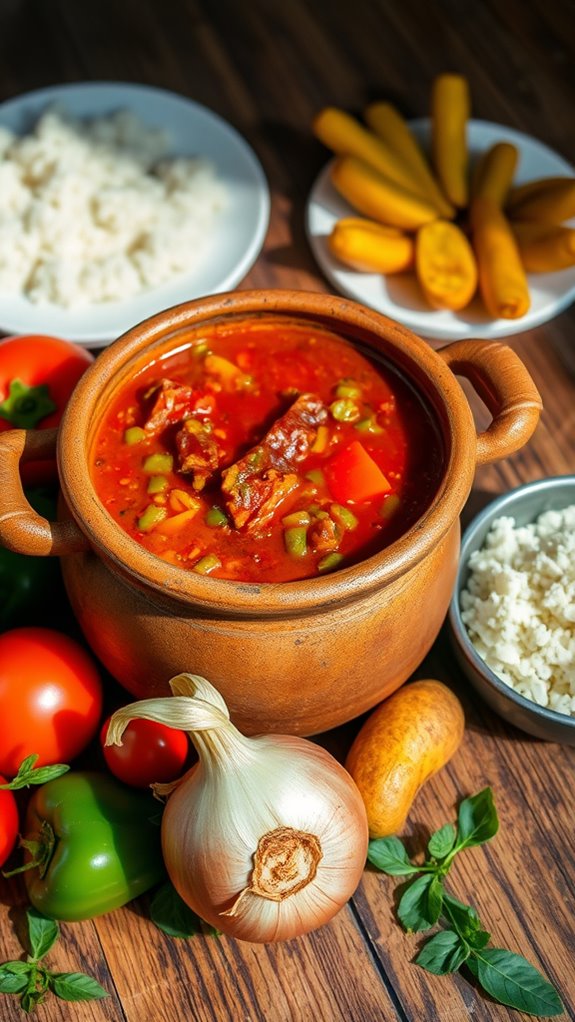Think of Nigerian stew as a vibrant tapestry woven from the rich culinary heritage of Nigeria. This dish isn't just a meal; it's an experience, bursting with flavors that tell stories of tradition and variety. With the right blend of ingredients and proteins, you can create a version that's uniquely your own. Curious about how to craft this delightful stew that captures the essence of Nigeria? Let's explore the details together.
History
When you immerse yourself in the rich flavors of Nigerian stew, you're not just tasting a meal; you're experiencing a culinary tradition steeped in history.
This stew isn't merely a dish; it embodies the cultural significance of Nigeria, reflecting the diverse communities and their stories. Originating from indigenous practices, it showcases how ingredients—such as tomatoes, peppers, and spices—are central to many families' kitchens.
You'll notice regional variations that bring unique twists, influenced by local customs and available produce. For instance, the fiery pepper soups of the south differ dramatically from the richer, oilier variations in the north.
Each bowl tells a story, connecting you to centuries of heritage and illustrating the importance of food in Nigerian identity.
Recipe

Nigerian stew, also known as "Nigerian tomato stew," is a versatile and flavorful dish that's a staple in Nigerian cuisine. It forms the base for many meals and can be served with rice, yams, or even pasta. This rich and aromatic stew is typically made with a blend of tomatoes, peppers, and onions, along with a variety of spices and proteins, giving it a unique and delightful taste that represents the heart of Nigerian cooking.
Making Nigerian stew isn't only easy but also allows for customization based on personal taste preferences. You can use different types of meat or even make it vegetarian by excluding meat and focusing on the robust flavors of the vegetables and spices. The combination of fresh ingredients and seasonings will surely make this dish a favorite in your household.
Ingredients:
- 6 medium-sized tomatoes
- 2 red bell peppers
- 1 green bell pepper
- 1 medium onion
- 2 cloves of garlic
- 1 teaspoon grated ginger
- ½ cup vegetable oil
- 2 teaspoons ground crayfish (optional)
- 2 teaspoons ground pepper (or to taste)
- 2 teaspoons curry powder
- 1 teaspoon thyme
- Salt to taste
- 2 cups of protein (chicken, beef, fish, or tofu)
- 1–2 cups water or stock
Cooking Instructions:
Begin by blending the tomatoes, red and green bell peppers, onion, garlic, and ginger together until smooth.
In a large pot, heat the vegetable oil over medium heat, then pour in the blended mixture. Cook for about 15–20 minutes, stirring occasionally until the sauce thickens and the oil begins to separate from the stew.
Add the ground crayfish, ground pepper, curry powder, thyme, salt, and your choice of protein. Pour in water or stock as needed, cover, and simmer for an additional 30–40 minutes until the protein is cooked through and tender.
Extra Tips:
When preparing this stew, feel free to adjust the spice levels to suit your preference. You can add more or less of the pepper, and if you prefer a smoother texture, you may blend the stew to your liking.
For a richer taste, consider roasting the tomatoes and peppers before blending. Additionally, Nigerian stew can be made in larger batches and freezes well, making it perfect for meal prep or busy weeknights.
Enjoy experimenting with different ingredients and flavors to create your own signature Nigerian stew!
Nutritional Guide
Understanding the nutritional profile of Nigerian stew not only enhances your appreciation for this dish but also helps you make informed choices for your meals. Packed with a variety of ingredients, this stew offers a delightful balance of flavor and nutrition. The caloric content varies based on the additions you choose, like protein sources and oil. Just a serving can provide a substantial amount of energy for your day.
Moreover, Nigerian stew is rich in vitamin sources, especially from tomatoes, bell peppers, and onions. These ingredients contribute vitamins A, C, and E, which boost your immune system and promote healthy skin.
Final Thought
As you savor each spoonful of Nigerian stew, it's clear that this dish is more than just a meal—it's a vibrant expression of culture and tradition.
Each bite tells a story, reflecting the rich heritage and communal spirit of Nigeria. The cultural significance of this stew runs deep, often enjoyed during celebrations or family gatherings, fostering connection and warmth.
You might notice the flavor variations depending on regional ingredients or personal recipes, from spicy peppers to rich seasonings, each adding its unique twist.
Embracing Nigerian stew means exploring a world of aromatic spices and fresh produce that tantalize your taste buds.
